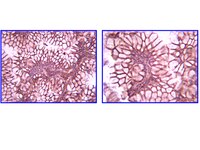Type IV collagen stimulates pancreatic cancer cell proliferation, migration, and inhibits apoptosis through an autocrine loop
Daniel Öhlund 1 , Oskar Franklin, Erik Lundberg, Christina Lundin, Malin Sund
BMC Cancer
13
154
2013
Show Abstract
Background: Pancreatic cancer shows a highly aggressive and infiltrative growth pattern and is characterized by an abundant tumor stroma known to interact with the cancer cells, and to influence tumor growth and drug resistance. Cancer cells actively take part in the production of extracellular matrix proteins, which then become deposited into the tumor stroma. Type IV collagen, an important component of the basement membrane, is highly expressed by pancreatic cancer cells both in vivo and in vitro. In this study, the cellular effects of type IV collagen produced by the cancer cells were characterized. <br />Methods: The expression of type IV collagen and its integrin receptors were examined in vivo in human pancreatic cancer tissue. The cellular effects of type IV collagen were studied in pancreatic cancer cell lines by reducing type IV collagen expression through RNA interference and by functional receptor blocking of integrins and their binding-sites on the type IV collagen molecule. <br />Results: We show that type IV collagen is expressed close to the cancer cells in vivo, forming basement membrane like structures on the cancer cell surface that colocalize with the integrin receptors. Furthermore, the interaction between type IV collagen produced by the cancer cell, and integrins on the surface of the cancer cells, are important for continuous cancer cell growth, maintenance of a migratory phenotype, and for avoiding apoptosis. <br />Conclusion: We show that type IV collagen provides essential cell survival signals to the pancreatic cancer cells through an autocrine loop. | 23530721
 |
Regulation of PDGFC signalling and extracellular matrix composition by FREM1 in mice.
Wiradjaja, F; Cottle, DL; Jones, L; Smyth, I
Disease models & mechanisms
6
1426-33
2013
Show Abstract
Fras1-related extracellular matrix protein 1 (FREM1) is required for epidermal adhesion during embryogenesis, and mice lacking the gene develop fetal skin blisters and a range of other developmental defects. Mutations in members of the FRAS/FREM gene family cause diseases of the Fraser syndrome spectrum. Embryonic epidermal blistering is also observed in mice lacking PdgfC and its receptor, PDGFRα. In this article, we show that FREM1 binds to PDGFC and that this interaction regulates signalling downstream of PDGFRα. Fibroblasts from Frem1-mutant mice respond to PDGFC stimulation, but with a shorter duration and amplitude than do wild-type cells. Significantly, PDGFC-stimulated expression of the metalloproteinase inhibitor Timp1 is reduced in cells with Frem1 mutations, leading to reduced basement membrane collagen I deposition. These results show that the physical interaction of FREM1 with PDGFC can regulate remodelling of the extracellular matrix downstream of PDGFRα. We propose that loss of FREM1 function promotes epidermal blistering in Fraser syndrome as a consequence of reduced PDGFC activity, in addition to its stabilising role in the basement membrane. | 24046351
 |










